Wakefield Cathedral
| Wakefield Cathedral | |
|---|---|
| Cathedral Church of All Saints | |
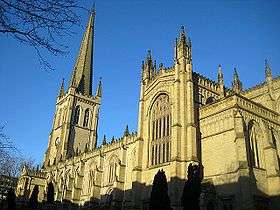 Wakefield Cathedral | |
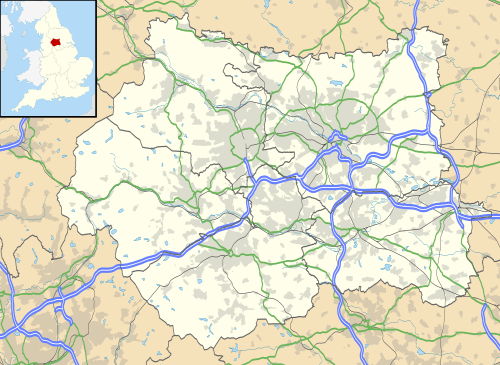 Wakefield Cathedral Shown within West Yorkshire | |
| Coordinates: 53°40′59″N 1°29′49″W / 53.68306°N 1.49694°W | |
| Location | Wakefield, West Yorkshire |
| Country | United Kingdom |
| Denomination | Church of England |
| Tradition | High Church/Anglo-Catholic |
| Website | www.wakefield-cathedral.org.uk |
| Architecture | |
| Heritage designation | Grade I listed building |
| Architect(s) |
George Gilbert Scott John Loughborough Pearson |
| Style | Gothic |
| Years built | c.1300-1905 |
| Specifications | |
| Spire height | 247 feet (75 m) |
| Administration | |
| Parish | All Saints, Wakefield |
| Deanery | Wakefield |
| Archdeaconry | Pontefract |
| Episcopal area | Wakefield |
| Diocese | Leeds (since 2014) |
| Province | York |
| Clergy | |
| Bishop(s) | Nick Baines |
| Dean |
vacant Acting: Macpherson |
| Subdean | Tony Macpherson (Canon Pastor) |
| Precentor | Leah Vasey-Saunders |
| Canon(s) |
John Lawson (Canon Librarian & Dir. Training) Derek Walmsley (DDO) |
| Curate(s) | Tim Stevens |
| Laity | |
| Director of music | Thomas Moore |
| Organist(s) | James Bowstead (assistant) |
Wakefield Cathedral, or the Cathedral Church of All Saints in Wakefield, West Yorkshire, United Kingdom, is one of three co-equal Anglican cathedrals for the Diocese of Leeds and a seat of the Bishop of Leeds. Originally the parish church, it has Anglo Saxon origins and after enlargement and rebuilding has the tallest spire in Yorkshire. Its 247-foot (75 m) spire is the tallest structure in the City of Wakefield.
The cathedral was designated a Grade I listed building on 14 July 1953.[1]
History
The cathedral, situated in the centre of Wakefield on a hill on Kirkgate,[nb 1] is built on the site of a Saxon church, evidence of which was uncovered in 1900 when extensions to the east end were made.[4] A church in Wakefield is mentioned in the Domesday Book of 1086. In 1090 William II gave the church and land in Wakefield to Lewes Priory in Sussex and shortly after that a Norman church was built.
The Norman church was rebuilt in 1329, and apart from the tower and spire, rebuilt and enlarged in 1469. The church was reconstructed and altered at various times and its spire, damaged in a violent gale, was renewed in 1823.[5] Up to the 16th century the church was known by the Anglo Saxon All Hallows and after the Reformation changed to All Saints.[6]
All Saints' Church was largely rebuilt in the Perpendicular Gothic style in the early 15th century and, after years of neglect in the 18th century, owes its current late mediaeval appearance to a Victorian restoration by George Gilbert Scott and his son John Oldrid Scott between 1858 and 1874.[7] In 1888, the Diocese of Wakefield was created and All Saints' Church became the cathedral of the diocese. It still serves as a parish church, meaning that until 2000 the head of the chapter of canons was called the provost, rather than the dean. The Treacy Hall built in memory of Bishop Eric Treacy was completed in 1982.[8]
In January 2000 a parish boundary change brought the chantry chapel, on Wakefield Bridge, into the care of the cathedral.[9]
In 2005 Queen Elizabeth II visited the cathedral to distribute Maundy money.[10]
In 2012 the cathedral, with £1.58 million of Heritage Lottery funding, had raised £2.5 million to restore and reorder the nave which was to be cleared of its oak pews to create an open space for worship, public events and celebrations.[11] A decision to charge VAT on restoration work on historic buildings in the 2012 budget caused concern that the project would be halted or delayed.[12]
Its archives are held at West Yorkshire Archive Service in Wakefield.[13]
Structure
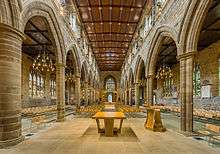
The cathedral walls are clad in ashlar sandstone. On the south wall is a porch, with a wrought iron gate and a sundial over the door arch. The wall of the north aisle is the oldest part of the church dating from about 1150. The nave piers date from the 12th and 13th centuries and the arcade and chancel arches date from the 14th century. The late 15th-century chancel now serves as the choir. The nave's original stone vaulted roof has been replaced with wood.[1] The 15th-century wooden ceilings over the nave and aisles have carved bosses.[7]
The current chancel, a transept and St Mark's Chapel were built at the east end in 1904 to designs by John Loughborough Pearson and completed by his son, Frank L Pearson. The 20th-century chancel has a stone vaulted roof.
The cathedral's large four-stage west tower has angle buttresses and a very tall crocketed spire behind an embattled parapet with crocketed corner pinnacles and at 247 feet (75 m) tall, is the highest spire in Yorkshire.[14][15]
Fixtures and fittings
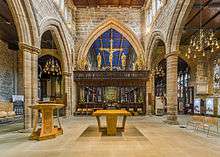
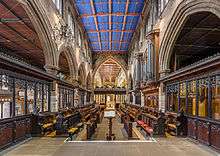
The cathedral's windows have some panel tracery.[1] None of the medieval stained glass survives and most of the cathedral's glass was created by Charles Eamer Kempe who created many windows over 50 years.[7] His windows are reminiscent in colour of those of the late Middle Ages, darker on the north wall with Old Testament themes and lighter on the south side where he placed New Testament figures.[16]
The cathedral has a 17th-century rood screen and above it a rood by Ninian Comper completed in 1950.[17] The font dates from the mid 17th-century and the pulpit from 1708.[1] Eleven of the 15th-century choir stalls, the gift of Thomas Savile, have misericords and other carvings including a green man and mythical beasts.[18]
The reredos is the work of John Oldrid Scott and possibly incorporates earlier works while the high altar is by Frank Pearson.[19] Some furniture in St Mark's Chapel is by Robert Thompson, the 'Mouseman'. The cathedral has a fine collection of church plate. A monument to Lyon Pilkington dates from about 1700 and other memorial tablets are from the 18th and early 19th centuries.[1]
The organ built by Abbott and Smith in 1902, has a case made in 1743. It was rebuilt by John Compton in London in 1951-52 and rebuilt and restored by Phillip Wood and Sons of Huddersfield in 1985.[20]
The cathedral tower has a ring of 14 bells including a 35-1-0 cwt, (note C) tenor, a flat 6th (note B flat), and extra treble (note A), to give a light 10 in (note F) (tenor 14 cwt). No more than 12 bells are usually rung at any one time. Practices range from rounds and call changes on six up to "Surprise Maximus". The bells are rung on Sundays, and to mark special occasions such as weddings and national events such as the Diamond Jubilee of Elizabeth II.[21]
Dean and chapter
As of 22 January 2018:[22]
- Dean — vacant since 26 November 2017
- Acting Dean, Sub Dean & Canon Pastor — Tony Macpherson (canon since 2007; Sub-Dean since 11 January 2014;[23] Acting Dean since 2017; previously Canon Missioner)
- Canon Librarian and Diocesan Director of Training — John Lawson (since 18 September 2005 installation)[24]
- Residentiary Canon and Diocesan Director of Ordinands — Derek Walmsley (since 15 November 2015 installation)[25]
- Canon Precentor — Leah Vasey-Saunders (since 5 June 2016 installation)[26]
Music

Wakefield Cathedral Choir, directed by Thomas Moore, consists of boys, girls and men who perform at the cathedral and have appeared on BBC One's Songs of Praise and BBC Radio 3's Choral Evensong.[27] In 1992 Wakefield Cathedral became only the second cathedral in Britain to accept female choristers.
The cathedral has had five organists since 1888,[28] of which Jonathan Bielby, MBE[29] was the longest serving organist in an English cathedral.[30] Since 2018 the Assistant Director of Music has been James Bowstead. Previous organists have included composer Newell Smith Wallbank. Assistant organists have included William Frederick Dunnill, John Scott and Peter David Gould.
See also
References
Notes
Citations
- 1 2 3 4 5 Historic England, "Cathedral Church of All Saints, Kirkgate (1258237)", National Heritage List for England, retrieved 3 June 2012
- ↑ Mills 1998, p. 403
- ↑ Mills 1998, p. 405
- ↑ Walker 1966, p. 172
- ↑ Lewis, Samuel (1848), "Wakefield", A Topographical Dictionary of England, British History Online, pp. 432–436, retrieved 3 June 2012
- ↑ Walker 1966, p. 169
- 1 2 3 Faith Trail (PDF), Treasures Revealed, retrieved 3 June 2012
- ↑ Warburton & Taylor 2006, p. 24
- ↑ Warburton & Taylor 2006, p. 21
- ↑ Royal Maundy Service, royal.gov.uk, archived from the original on 10 May 2012, retrieved 3 June 2012
- ↑ Wakefield Cathedral restoration work begins, The BBC, retrieved 3 June 2012
- ↑ "Wakefield Cathedral dean's wife takes on George Osborne in YouTube song", The Guardian, 5 April 2012, retrieved 3 June 2012
- ↑ West Yorkshire Archives, WYJS, ISBN 1-870453-11-5, retrieved 15 March 2010
- ↑ Wakefield Cathedral, History & Architecture, Wakefield Catheppearance to a dral, retrieved 4 September 2010
- ↑ Wakefield Council - Wakefield Cathedral, Wakefield Council, retrieved 4 September 2010
- ↑ Warburton & Taylor 2006, p. 114
- ↑ Warburton & Taylor 2006, p. 8
- ↑ Warburton & Taylor 2006, p. 11
- ↑ Warburton & Taylor 2006, p. 12
- ↑ National Pipe Organ Register, NPOR, retrieved 15 March 2010
- ↑ Bell Ringing, Wakefield Cathedral, retrieved 3 June 2012
- ↑ Wakefield Cathedral — The Clergy (Accessed 22 January 2018)
- ↑ Diocese of Leeds — New Sub Dean at Wakefield Cathedral announced (Accessed 22 January 2018)
- ↑ Wakefield Cathedral — Events, Lent 2005
- ↑ Wakefield Cathedral — weekly sheet, 8 November 2015 (Accessed 22 January 2018)
- ↑ Diocese of Leeds — New Canon Precentor finds her way home as team grows at Wakefield Cathedral announced (Accessed 22 January 2018)
- ↑ Cathedral choir, wakefieldcathedral.org.uk, archived from the original on 28 May 2009, retrieved 20 November 2009
- ↑ The Organ, Wakefield Cathedral, retrieved 4 June 2012
- ↑ Jonathan Bielby awarded MBE, Wakefield Diocese, retrieved 3 June 2012
- ↑ Songs of Praise factsheet for Sunday 20 January 2008, The BBC, retrieved 3 June 2012
Bibliography
- Mills, A.D. (1998), A Dictionary of English Placenames, Oxford University Press, ISBN 0 19 280074 4
- Sisson, Joseph Lawson (1824), Historic sketch of the parish church, Wakefield, Richard Nichols
- Walker, J.W. (1966), Wakefield its History and People Vol.1&2 3rd Edn, S.R. Publishers
- Warburton, Malcolm; Taylor, Kate (2006), Sue Robinson, ed., Wakefield Cathedral, Jarrold, ISBN 978-0-7117-4228-4
External links

- Wakefield Cathedral
- Wakefield Cathedral on Skyscrapernews.com